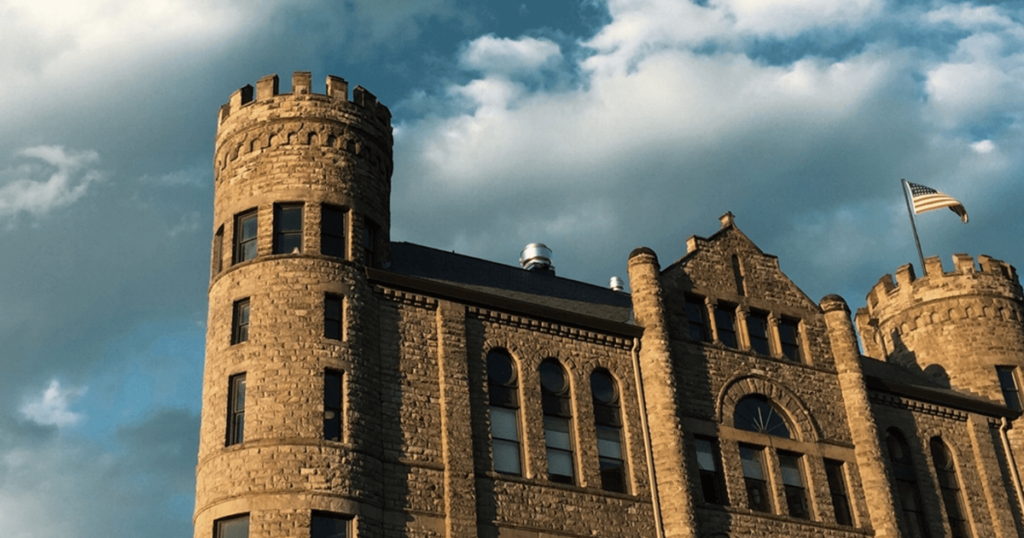
carl
—Detroit named North America’s top “unexpected” food city by Nat Geo
Detroit Free Press headline, January 17, 2017
It’s Thursday morning in the dead of summer, and Steven and I just returned from dropping our daughter, Celia, at the airport for her first solo trip out of town. While she skyrockets toward Charleston, we’re here, licking our metaphorical wounds (and chops!) at that hot & happening diner, Parks and Rec. This (downtown? Midtown? call it Stadiumtown) eatery is two years old now, and located in the omnipresent, 19th-century castle known as the Grand Army of the Republic—a building erected for Civil War veterans that went on to house Detroit’s Parks and Recreation Department in the early 1940s.
Skipping ahead to 1982, when Motown was in the throes of its protracted collapse and maintenance on the GAR became unmanageable, Mayor Coleman Young ordered it boarded up—and so it languished for three decades in what was, by then, an emptied-out neighborhood.
Was anything happening around here during those years? I ask Steven, who visits Motown’s numerous communities more often than I do. He thinks a moment, as we scrounge for change at the gleaming-new parking meter alongside the GAR. Not really, he finally says. The area was pretty much homeless guys, prairie grass, and crumbling buildings far as the eye could see.
Not like now. Because three local businessmen renovated the GAR to its faux-medieval glory, complete with crenellated turrets soaring mightily toward heaven. Within its no-longer-crumbling walls, you’ll find not one, but two restaurants (Parks and Rec, and its older by a year sister, Republic Tavern), which, like certain portions of Detroit, appear to be thriving. In fact, this once-ghost town of a district is jumping with new residents, with two stadiums and another well on its way, and with theaters, clubs, construction everywhere you look. With more restaurants that are hungry to give P and R and Republic a run for their money.
Speaking of money, when we’ve got a little to spare, our family likes to check out Detroit’s recently opened cafés and bistros and brasseries. We can’t visit them all, of course, but to our delight, every place we’ve tried has been pretty good. More often, they’re marvelous.
Maybe we’ve just been lucky, but I don’t think that wholly accounts for our positive dining experiences. These restaurants, like so many recently sprung-up Detroit businesses, are searching out, and claiming, their unique niches in this singular city. Take Republic Tavern. According to manager Lisa Carlton, at least half their produce hails from Detroit’s flourishing urban farms—indeed, all the garnishes prettifying today’s meals at both Republic and P and R were delivered last night by a guy dragging wagons-full of greenery (and two kids) behind his bicycle.
As a side-note: when our family dined at Republic, we avoided the fish-heads entrée, even as, I’m told, it sold out over and over again. No, says Steven. I don’t think it was on the menu when we went. I definitely would’ve ordered it. And I believe him—Steven used to be a chef before he turned teacher, and chefs will try everything.
The point is, after the near-demise of fine dining in Detroit (in the ’80s and ’90s, with the passing of granddames like Carl’s Chophouse, Ponchartrain Hotel, Caucus Club, etc.), Motown can once again support dozens (and dozens) of medium to high-end restaurants. Not to mention the underground pop-up scene, where hip, young chefs unaffiliated with conventional establishments appear for a night or two at diverse locations to whip up innovative cuisine for their cool clientele. According to Nick George, AKA Dr. Sushi—pop-up chef extraordinaire and founder of Detroit Pop-Up Alliance—Detroit hosts 10-15 such pop-ups a week. Further, pop-up prices tend to be lower then those of their conventional cousins, more culturally varied foods are represented, and more people of color participate (as both patrons and owners of these micro-businesses). So everybody wins, right?
Never mind that pop-ups exist in a legal gray area—and anyway, we Detroiters are perfectly comfortable with that, in this place where bureaucracy is sludge-thick. Where, in order to complete a simple home project, many people just avoid the (drudging, go-to-the-back-of-the-line!) permitting process. Where car insurance is so exorbitant (highest costs in the nation!) that desperate folks resort to seven-day policies sold at local bureaus just to renew their licenses. Then they drop the cheapo-insurance immediately, drive painfully slowly on our crumbling roads—just to be safe—and make me, stuck behind these slog-alongs, bang on my dashboard because I’m always late.
But, whatever. Because suddenly we’ve got some successful neighborhoods, and a plethora of places to satisfy our hunger. So that even now in Parks and Rec, Steven and I are gleefully wolfing down ricotta cakes with lemon curd and pickled raspberry preserves. And everything’s swell in Motown, yes? Well, mostly …
Except, according to the 2010 census, the median income of pre-bankruptcy Detroiters hovered around $25,000. I doubt that’s risen significantly for lots of residents, even as we’re riding the rebound swing. In June 2016, NPR’s Michigan Radio reported, “A government survey recently showed 57 percent of Detroit children live in poverty. Thirty-nine percent of all households are impoverished.” So, I have to ask, who are all these people enjoying our resurgence of not-so-cheap eateries (and concerts and ball games and boutiques and park-opening festivals)? Are they suburbanites come out for the day? Yay—welcome back! Or new residents? Yay again!
But what about Detroit’s long-time citizens, the ones trapped in not-so-popular neighborhoods, without access to decent-paying jobs, without dependable, affordable transportation? Are they, too, engaged in this frenzy of dining and revival? Right now, I’m guessing not so much.
We can only hope this will change soon, as our progress seeps into the city’s under-served areas. After all, these folks stuck it out through the bad (really terrible) times—shouldn’t they also get to share in the bounty of new-Detroit?

